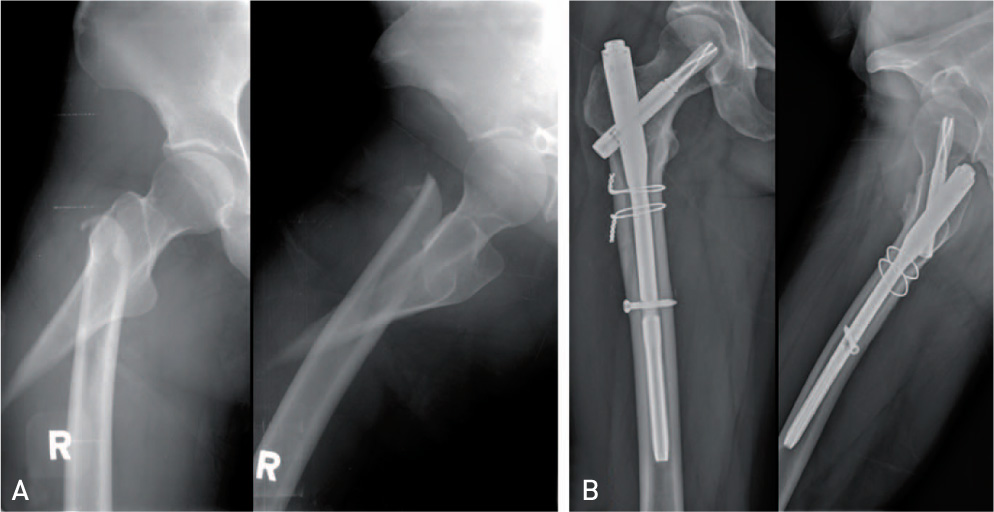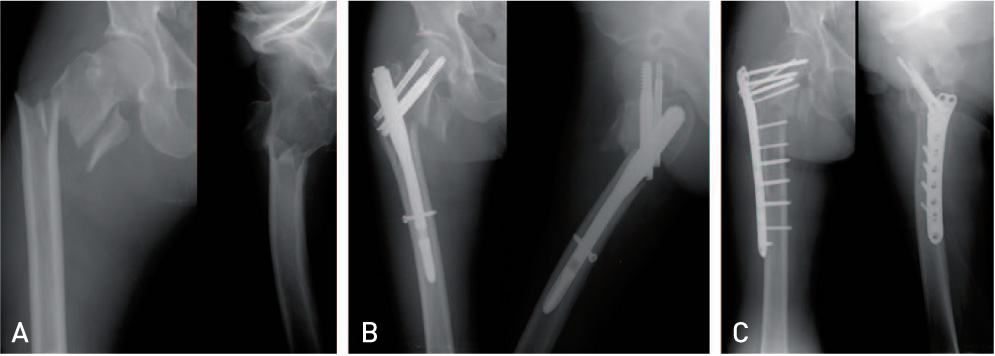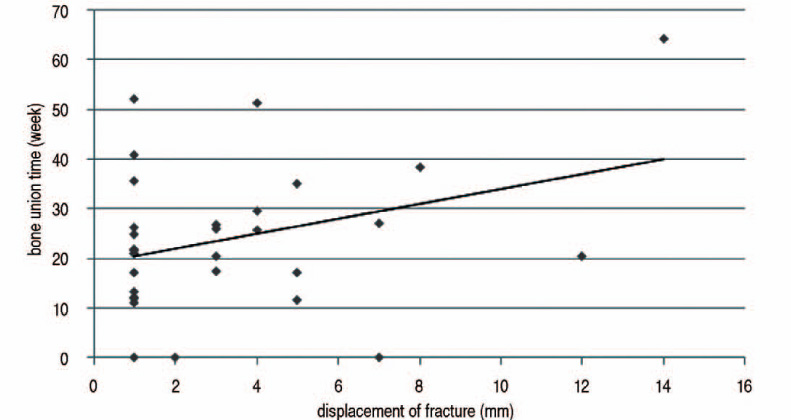Hip Pelvis.
2014 Jun;26(2):107-114. 10.5371/hp.2014.26.2.107.
Factors Affecting Time to Bony Union of Femoral Subtrochanteric Fractures Treated with Intramedullary Devices
- Affiliations
-
- 1Department of Orthopedic Surgery, Inje University Sanggye Paik Hospital, Inje University College of Medicine, Seoul, Korea. ybs58@paik.ac.kr
- KMID: 2054172
- DOI: http://doi.org/10.5371/hp.2014.26.2.107
Abstract
- PURPOSE
To evaluate the factors affecting the bone union time and the occurrence of nonunion after intramedullary nailing of subtrochanteric femoral fractures in adults.
MATERIALS AND METHODS
We retrospectively reviewed data from 31 patients (22 men and 9 women) who had undergone femoral intramedullary nailing at least 1 year post-operatively and analyzed the bone union time, nonunion rates, and factors that affected the bone union time according to the fracture classification (AO and Fielding classifications), comminution of the medial cortex, reduction method, and additional cerclage wiring.
RESULTS
The average union time was 26.4 weeks. There were no differences in the bone union time according to the fracture classification, reduction method, or additional cerclage wiring. Significant differences were found in the bone union time between the medial cortex comminution and non-comminution groups. A relatively strong positive correlation was detected between the degree of post-operative displacement and the bone union time. Nonunion occurred in three cases and there was no failure of implants.
CONCLUSION
The bone union time was not affected by the reduction method nor additional cerclage wiring in intramedullary nailing of subtrochanteric femur fractures. Comminution of the medial cortex and the degree of the postoperative displacement of fractures contributed to the delayed time of union.
MeSH Terms
Figure
Reference
-
1. Lee SH. Surgical treatment of femoral subtrochanteric fracture. J Korean Hip Soc. 2006; 18:430–436.2. Kim JJ, Kim JW. Subtrochanteric fracture: intramedullary nailing. J Korean Fract Soc. 2009; 22:114–122.
Article3. Yoon TR, Rowe SM, Song EK, Seol JY, Shin SG. Treatment of subtrochanteric fracture - Comparison of treatment efficacy according to internal fixation device. J Korean Soc Fract. 2001; 14:189–199.
Article4. Shin YW, Sung YB, Choi JY, Kim M. Analysis of risk factors for nonunion after intramedullary nailing of femoral shaft fracture in adult. J Korean Fract Soc. 2011; 24:313–320.
Article5. Karadimas EJ, Papadimitriou G, Theodoratos G, Papanikolaou A, Maris J. The effectiveness of the antegrade reamed technique: the experience and complications from 415 traumatic femoral shaft fractures. Strategies Trauma Limb Reconstr. 2009; 4:113–121.
Article6. Noumi T, Yokoyama K, Ohtsuka H, Nakamura K, Itoman M. Intramedullary nailing for open fractures of the femoral shaft: evaluation of contributing factors on deep infection and nonunion using multivariate analysis. Injury. 2005; 36:1085–1093.
Article7. Taitsman LA, Lynch JR, Agel J, Barei DP, Nork SE. Risk factors for femoral nonunion after femoral shaft fracture. J Trauma. 2009; 67:1389–1392.
Article8. Koval KJ, Skovron ML, Aharonoff GB, Meadows SE, Zuckerman JD. Ambulatory ability after hip fracture. A prospective study in geriatric patients. Clin Orthop Relat Res. 1995; 310:150–159.9. Fielding JW, Magliato HJ. Subtrochanteric fractures. Surg Gynecol Obstet. 1966; 122:555–560.
Article10. Lee KH, Kim HM, Kim YS, et al. Treatment of subtrochanteric fractures with compression hip screw. J Korean Fract Soc. 2006; 19:1–5.
Article11. Kyle RF, Cabanela ME, Russell TA, et al. Fractures of the proximal part of the femur. Instr Course Lect. 1995; 44:227–253.
Article12. Malkawi H. Bone grafting in subtrochanteric fractures. Clin Orthop Relat Res. 1982; 168:69–72.
Article13. Fielding JW, Cochran GV, Zickel RE. Biomechanical characteristics and surgical management of subtrochanteric fractures. Orthop Clin North Am. 1974; 5:629–650.
Article14. Park KC, Kim HS. Efficacy of percutaneous cerclage wiring in intramedullary nailing of subtrochanteric femur fracture: Technical note. J Korean Fract Soc. 2013; 26:212–216.
Article15. Schatzker J, Waddell JP. Subtrochanteric fractures of the femur. Orthop Clin North Am. 1980; 11:539–554.
Article16. Kim JW, Chang JS, Lee H, Bae JY, Kim JJ. Clinical results of femoral subtrochanteric fractures. J Korean Hip Soc. 2010; 22:222–226.
Article17. Charnley J. The closed treatment of common fractures. 3rd ed. London: E & S Livingstone;1963.18. Newton CD, Hohn RB. Fracture nonunion resulting from Cerclage appliances. J Am Vet Med Assoc. 1974; 164:503–508.19. Partridge AJ, Evans PE. The treatment of fractions of the shaft of the femur using nylon cerclage. J Bone Joint Surg Br. 1982; 64:210–214.
Article20. Fitzgerald JA, Southgate GW. Cerclage wiring in the management of comminuted fractures of the femoral shaft. Injury. 1987; 18:111–116.
Article21. Park CH, Ha CW, Park SJ, Ko MS, Shon OJ. Fixation of the femoral subtrochanteric fracture with minimally invasive reduction techniques. J Korean Fract Soc. 2013; 26:112–117.
Article22. Afsari A, Liporace F, Lindvall E, Infante A Jr, Sagi HC, Haidukewych GJ. Clamp-assisted reduction of high subtrochanteric fractures of the femur. J Bone Joint Surg Am. 2009; 91:1913–1918.
Article23. Kennedy MT, Mitra A, Hierlihy TG, Harty JA, Reidy D, Dolan M. Subtrochanteric hip fractures treated with cerclage cables and long cephalomedullary nails: a review of 17 consecutive cases over 2 years. Injury. 2011; 42:1317–1321.
Article24. Ban I, Birkelund L, Palm H, Brix M, Troelsen A. Circumferential wires as a supplement to intramedullary nailing in unstable trochanteric hip fractures: 4 reoperations in 60 patients followed for 1 year. Acta Orthop. 2012; 83:240–243.
Article25. Hwang CS, Chung PH, Kang S, et al. Treatment of subtrochanteric femur fractures using intramedullary devices. J Korean Fract Soc. 2008; 21:13–18.
Article26. Müller T, Topp T, Ku¨hne CA, Gebhart G, Ruchholtz S, Zettl R. The benefit of wire cerclage stabilisation of the medial hinge in intramedullary nailing for the treatment of subtrochanteric femoral fractures: a biomechanical study. Int Orthop. 2011; 35:1237–1243.
Article
- Full Text Links
- Actions
-
Cited
- CITED
-
- Close
- Share
- Similar articles
-
- Comparison between Intramedullary and Plate Fixation for Subtrochanteric Fracture of the Femur
- The Operative Treatment of Subtrochanteric Fractures of the Femur
- Characteristics and Surgical Outcomes of Intertrochanteric or Subtrochanteric Fractures Associated with Ipsilateral Femoral Shaft Fractures Treated with Closed Intramedullary Nailing: A Review of 31 Consecutive Cases over Four Years at a Single Institution
- Treatment of Subtrochanteric Fractures with Compression Hip Screw
- Factors Affecting the Period of Bone Union When Treating Femoral Fractures with a Retrograde Intramedullary Nail




